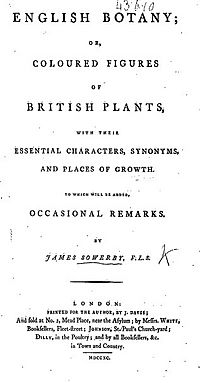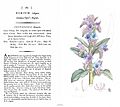English Botany facts for kids

Title page from the book
|
|
| Author | James Sowerby, James Edward Smith & others |
|---|---|
| Illustrator | James Sowerby |
| Country | England |
| Language | English |
| Series | 36 Volumes |
| Subject | Botanical publication |
| Publisher | James Sowerby |
|
Publication date
|
December 1790 to September 1814 |
| Media type | Letterpress plus 2,592 hand-coloured, engraved plates. |
| Pages | 5,416 (including indexes) |
English Botany was a huge collection of books about British plants. It had 36 volumes and came out in monthly parts for 23 years, from 1791 to 1814. James Sowerby, a talented artist and expert in nature, created, drew, edited, and published the whole work.
The short descriptions for the plants were mostly written by Sir James Edward Smith. He was the person who started the Linnean Society of London. At first, Smith didn't want his name on the book. He thought working with an artist like Sowerby might make him seem less important to other scientists. But the book became super popular! So, Smith then insisted his name be added to the title page of later volumes. Even so, people usually called the book "Sowerby's Botany".
Contents
What is English Botany?
The full name of the book was English Botany or, Coloured Figures of British Plants, with their Essential Characters, Synonyms and Places of Growth. It included 2,592 detailed pictures of plants. These pictures were made from copper plates and then colored by hand. There were even 3 pictures that folded out! Each picture had its own page of text explaining the plant.
Finding Information in the Books
Each of the 36 volumes had its own index to help readers find plants. In 1814, Sowerby released a big, 42-page final index. This index had two parts with Latin names (one alphabetical, one by plant group). It also had an index of common English plant names. These final indexes were even sold to people who didn't subscribe to the whole series. They also included an index for Sowerby's other book, "Coloured Figures of English Fungi or Mushrooms".
How Comprehensive Was It?
At first, the book wasn't meant to include every British plant. Smith had started a similar project with his book Flora Britannica. However, by the time English Botany was finished, it had become the most complete illustrated guide to British plants ever published. It even included the first descriptions and drawings of many mosses and lichens. Both Sowerby and Smith loved studying these types of plants.
Why Was This Book Important?
The descriptions in English Botany were very accurate and well-organized. They used binomial nomenclature, which is a scientific way of naming plants with two Latin words. The book had both Latin and English descriptions. But it was also written for a wider audience, including general discussions and tips on growing plants.
Reaching a Wider Audience
More and more people were buying books, and many amateur gardeners and plant lovers were excited about botany. Because of this, English Botany became very well-known. The detailed pictures helped people identify plants accurately. This made the book useful, not just pretty. It was more like a serious science book than just a decorative one.
Other Projects by Sowerby and Smith
Smith and Sowerby worked together on other books too. For example, they created Icones pictae plantarum rariorum (1790-1793). They also worked on A Specimen of the Botany of New Holland. This book showed pictures of plants found in the new colonies of Australia.
Pictures vs. Text
Sowerby's hand-colored pictures were very beautiful and helped people who weren't plant experts identify plants. Many people praised Sowerby for his artistic skill. However, Smith secretly felt that pictures alone weren't enough to fully describe a plant. He publicly said that drawings needed proper descriptions and explanations. Without text, he believed, you could only get a "superficial knowledge" from a picture. He said this to explain to his fellow scientists why he agreed to write the text for Sowerby's book. Even though they came from different social classes, Sowerby and Smith were good friends. They worked happily on many projects for years.
Buying the Book in the Past
In 1814, Sowerby offered the complete English Botany set or individual pictures without text. The full set cost £55 7s. You could buy quarto-sized colored pictures (larger) for 1 shilling each. Smaller, octavo-sized pictures of specific plant types or groups cost 6 pence each.
How Rare Are Complete Sets?
Even though up to 900 copies of the engravings were made, very few complete first edition sets exist today. This is probably because the full set was very expensive. Also, it took a very long time to publish, during which there were tough times like wars and a famine. A full first edition set with all 5,416 pages is now extremely rare. Only three complete copies are known to exist, and they are all owned by private collectors. The pictures in the first edition are very high quality. They have such fine details that you need a very high-resolution scanner to copy them properly. Many partial sets exist, usually with only the first half or two-thirds of the work. No quarto-sized colored pictures from the first edition are known to have survived.
Later Editions and Supplements
Sowerby's son, James de Carle Sowerby, published two more parts (supplements) to the original work.
- The first supplement came out from 1829 to 1831. It added 100 new pictures (numbered 2592 to 2692) with their texts.
- The second supplement was published from 1831 to 1835. It had 104 more pictures (numbered 2693 to 2796), including two fold-out illustrations. These supplements were available either colored or plain. Most were sold plain and have since been lost.
Later versions of the book used machines to print colors. This made the books cheaper, but the picture quality was not as good. The original copper plates also wore out from being used so much. In the third edition (1863), the editor John Boswell changed the text and added a "popular portion." However, by this time, the original plates were so worn that many fine details had to be removed. James de Carle Sowerby often added new, lower-quality drawings and large, uncolored outlines of leaves. This made the pictures look much worse. Several more editions were made after this, using cheap materials and poor copying methods. Each new edition seemed to be copied from the one before it, making the picture quality worse and worse over time.
Example Plates
-
Hand coloured plate of Convolvulus soldanella (see Convolvulus), Sea Bindweed
See also
 In Spanish: English Botany para niños
In Spanish: English Botany para niños








